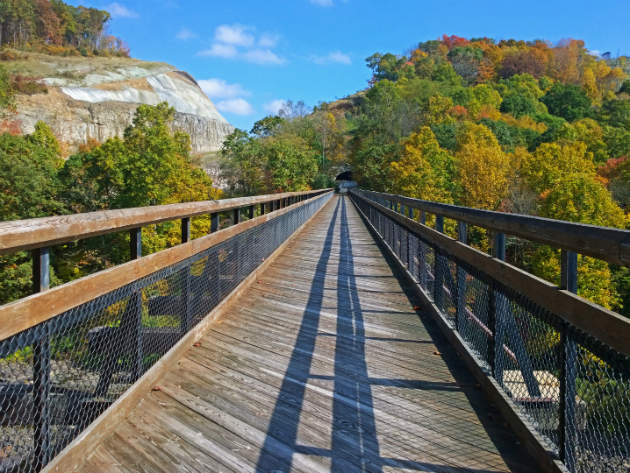
When old railways reach the end of their useful life, rather than being left to fall into disrepair, an arrangement called railbanking can ensure that the corridor is sold to developers for refurbishment.
The National Trails System Act in the US, adopted in 1983, has helped preserve and restore thousands of miles of rail corridors that would have otherwise been abandoned. Instead, old tracks be can be turned into parks, nature trails, cycle paths and public gardens that offer a much-welcomed green pocket at the heart of fully urbanised communities.
Rails to trails conservancy

Since 1986, the non-profit organisation Rails-to-Trails Conservancy (RTC) has mobilised more than 160,000 members and supporters to create an extensive network of trails from former railway lines and connecting corridors across the US.
Stretching over 30,000 miles, and with a further 8,000 miles poised for development, the organisation’s trails venture through open prairies, mountain passes, canyons and riverbanks.
Some of the longest trails in the US – such as Washington’s John Wayne Pioneer Trail, Missouri’s Katy Trail State Park or the Cowboy Trail in Nebraska, run for more than 150 miles, and 90% of each trail is built on a former railroad corridor.
Shorter routes, such as the 30-mile Chautauqua in south-eastern New York, or the ten-mile Portage Hike and Bike Trail in Ohio, offer visitors smaller pockets of wilderness.
The organisation draws the bulk of its funds from a number of US Government programmes, such as Transportation Alternatives. In 2015, RTC launched a new grant programme for the building and improvement of rail trails, which will award a total of $85,000 per year for the next five years to the best competing projects.
Before 2020, RTC also plans to expand and modernise its operations by developing new finance models drawn from federal, state, local and private sector investment, and implement modern data analysis to keep an eye on the economic case for each upcoming project.
The high line of rail parks
New York City’s High Line is a public park built on a former railway of the same name which dates from 1934.
After the last train ran on the High Line in 1980, the space was kept safe from demolition by the lobbying of Peter Obletz, a local railway enthusiast. In 1999 two neighbourhood residents formed Friends of the High Line, a non-profit that helped restore and operate what is now a public park owned by the City of New York.
Rising 30ft above street level, the park can be accessed via stairs set on steel beams. The structure’s most impressive feature is Tenth Avenue Square, an amphitheatre-like space with wooden seating that overlooks the Statue of Liberty and Hudson River.
The High Line is also big on sustainable practices. A multitude of gardens and small plantations, such as the Chelsea Thicket, the Wildflower Field and the Falcone Flyover, are organised into ’microclimates’ for growing locally sourced plants and native pollinators.
The park’s green roof is equipped with drip irrigation for enhanced water retention, and most garden waste is turned into compost, avoiding the use of pesticides or chemical fertilisers.
For over 15 years, Friends of the High Line has worked to raise the private funding needed to support the park’s annual operating budget.
Federation square public precinct

Federation Square, one of the most lauded architecture projects in Melbourne, is built on top of a working railway.
The 38,000m² space is an elevated structure that took 12 months to complete and is one of the largest expanses of railway decking ever built in Australia. The square, which hosts galleries, cinemas, and radio and television studios, rests on 3,000t of steel beams and 1.4km of concrete ‘crash walls’ and contains over 4,000 vibration-absorbing spring coils and rubber padding.
The project, which opened in 2003, was built only during breaks in the train timetable in the early hours of the morning.
Rail deck park connecting neighbourhoods

In August this year, Toronto’s Mayor John Tory announced a plan to create a 21-acre park above the rail corridor cutting through the city’s downtown area.
The Rail Deck Park project aims to connect King-Spadina neighbourhood, City Place and the Waterfront by removing the ’physical barrier’ of the rail corridor. As the area’s population is set to almost double before 2041, the city is keen to open a publicly accessible green space for the community.
Toronto’s authorities have taken inspiration from similar successful projects and put together an official development plan for its construction. Much like Federation Square in Melbourne, the plan explores the idea of decking over the Union Station Rail Corridor, which is still operational, and reclaiming the space above it for public use.
According to the city council’s website, the project is hoping to attract support from corporate sponsors, foundations, design experts and community groups.
Public transport operators such as Metrolinx, Canadian National Railway and Toronto Terminal Railways have already expressed interest in sharing ownership of the Rail Deck Park.
Arbutus Greenway for non-motor travel

The city of Vancouver is planning its own rail corridor restoration, after buying the Arbutus Corridor for $55m from Canadian Pacific Railway in March this year.
The vision is to build a north-south path that will connect False Creek to the Fraser River, creating a ’transportation greenway’ for pedestrians, bikes and ultimately streetcars.
Ahead of its delivery, the city council promised the construction of a temporary pathway between Fir Street and Milton Street that it says would “encourage people to explore and enjoy the corridor”.
When construction begins, the Arbutus Greenway will likely be funded in a similar fashion to Vancouver’s other ’greenway’ spaces: with funds from the city’s capital budget, as well as any other top-up support from government programmes, donations, non-profit agencies or business associations.




